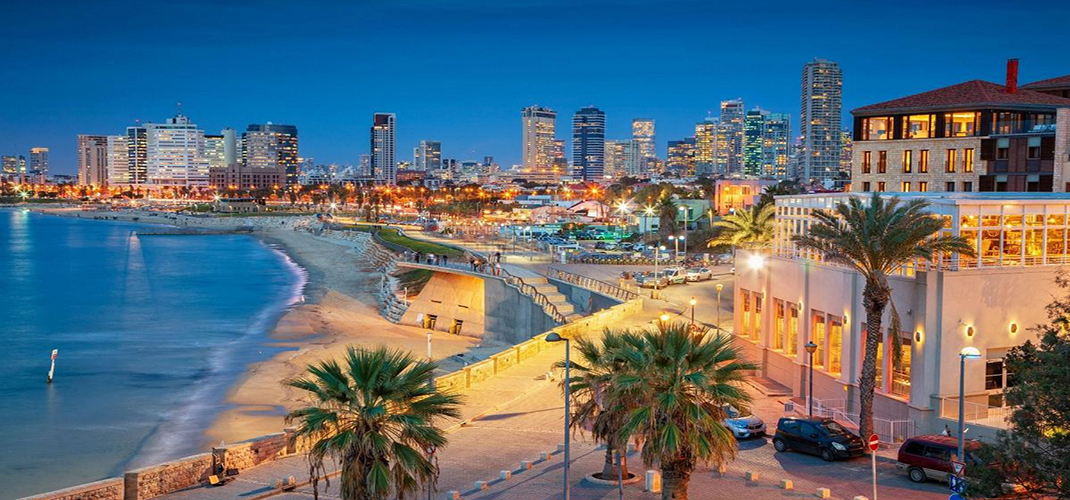Tel Aviv

Nicknamed 'The White City', the city of Tel Aviv was awarded UNESCO World Heritage Status in 2003 in recognition of its fine examples of Bauhaus architecture. Tel Aviv is also known for its long golden beaches and vibrant café culture. This cosmopolitan city has a laid back feel to it with a great dining scene, museums and galleries. For an authentic historic atmosphere then head south to Jaffa, the well preserved port town, which has a settlement history that dates back thousands of years.
A short walk along the coast brings you to the Old Arab Port Town of Jaffa, with its preserved Acropolis ruins and well restored stone architecture. The original Bazaar area is now home to restaurants and artisan boutiques and is particularly lively in the evening when the Old Town becomes crowded with diners. The flea market here has all the atmosphere of a genuine Souk. Other sites not to be missed are St. Peter's Monastery and the Old Port area.
Namal also known as Tel Aviv's Old Port has been revitalised into a trendy waterfront hangout full of shops and cafés. The area has private art galleries, an excellent indoor market and on weekends there is often live music concerts.
Tel Aviv’s beaches attract many visitors especially on weekends. The most popular beaches include Banana Beach, Gordon Beach and Frishman Beach. The Tayelet or paved boardwalk runs along the beach between central Tel Aviv and Jaffa and is lined with cafés and restaurants.
One of Tel Aviv's most atmospheric neighbourhoods would have to be the Yemenite Quarter with its alleyways lined by old style architecture. Yemenite Jews first settled here in the early 20th Century and the original feel of the closely packed streets are still very alive today. The neighbourhood backs onto Carmel Market a busy, colourful, fresh produce market.
Dizengoff Circle, is the central point of the city with its central plaza, arranged over two levels with a raised area for pedestrians above the carriageway and topped by the peculiar modern Fire and Water Fountain. The plaza and the street running off it are named after Meir Dizengoff, Tel Aviv's first mayor after the city separated from Jaffa. From the circle, Dizengoff Street runs southeast to Habima Square, Tel Aviv's cultural centre and home to the 1935 Habima Theatre. This is also where you'll find the excellent Helena Rubinstein Pavillion of Contemporary Art, which hosts a program of temporary art exhibits. Just off Habima Square, on Berdyczewski Street, is one of Tel Aviv's best speciality museums, the Joseph Bau House Museum located in the house where the famous Israeli artist and holocaust survivor lived and worked.
Rothchild Boulevard is the home to some of Tel Aviv's finest Bauhaus architecture and is a great place to take a stroll. There are two museums where you can stop and admire the preserved buildings including the Independence Hall (Beit Dizengoff), the former residence of Tel Aviv's first mayor and where David Ben-Gurion proclaimed the State of Israel on May 14th, 1948 and also the Haganah Museum, which documents the Haganah guerrilla force that actively attacked the British Mandate rule.
Tel Aviv’s major museum would have to be the Tel Aviv Museum of Art housing works by Degas, Picasso, Monet, Van Gogh and Jackson Pollock as well as the world's largest collections by Israeli artists. A particular highlight is the collection by Alois Breyer and his early 20th Century prints and architectural renderings of Ukrainian wooden Synagogues, all of which were destroyed during World War II.
Little Bialik Street is for those who are interested in history and culture, it is home to three historical houses including the house of artist Reuven Rubin, now a museum dedicated to his work, full of paintings, as well as old photographs of Tel Aviv. The Bialik House, which was once the residence of poet Chaim Nachman Bialik and now pays tribute to his life and works and the original Town Hall of Tel Aviv known as Beit Ha'ir, which contains displays documenting Tel Aviv's history.
The Eretz Israel Museum (Land of Israel Museum) occupies a complex of buildings that also takes in the Tell Qasile archaeological site. The complex includes a planetarium as well as exhibits on ceramics, glass, the history of writing, ethnography and science. In the centre of the complex the Tell Qasile is where Israeli archaeologists have identified 12 settlement levels that date back to the 12th Century B.C.
Beit Hatefutsoth or more commonly known as the Diaspora Museum or the Museum of the Jewish People, illustrates the life and culture throughout history of the Jewish people around the world. The museum displays a variety of exhibits and film recordings to document the world's Jewish population through the centuries.
The Yitzhak Rabin Centre, named after the former Prime Minister of Israel, is home to the Israel Museum, it includes a wealth of information about Israel itself as well as Yitzhak Rabin, who was assassinated by Jewish terrorists after making peace with Jordan in 1995. This museum houses detailed exhibits include a multitude of archived films and photographs.
The city’s oldest neighbourhood is the Neve Tzedek Quarter with European-Jewish settlers first building houses here in the 1880’s. These preserved old buildings house cafés, restaurants and arty boutiques. Here you will also find Rockach House, a small sculpture gallery and the Nachum Gutman Art Museum, displaying the artwork of this Israeli painter.
